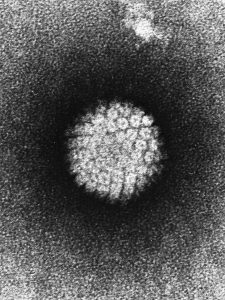Based on a study that included more than 1 million women, investigators at the National Institutes of Health have determined that a negative test for human papillomavirus (HPV) infection compared to a negative Pap test provides greater safety, or assurance, against future risk of cervical cancer. That is, women who test negative on the HPV test have an extremely low risk of developing cervical cancer. This finding, by researchers at the National Cancer Institute (NCI), part of the NIH, and their colleagues, appeared online July 18, 2014, in the Journal of the National Cancer Institute.

HPV tests detect the DNA (or RNA) of the human papillomavirus types that cause nearly all cervical cancers. The Pap test detects abnormal cell changes associated with the development of cervical cancer. Both types of test are performed on a sample of cells collected from the cervix.
Since 2003, women between the ages of 30 and 64 enrolled in Kaiser Permanente Northern California’s health care system have had cervical cancer screening with concurrent HPV and Pap testing (called cotesting). This group of women is the largest known in the United States with the longest history of HPV testing in routine clinical practice. In 2011, NCI researchers and their colleagues published findings on screening outcomes for about 300,000 of the women in this group. Those data were used to inform current U.S. cervical screening and management guidelines, including those of the U.S. Preventive Services Task Force (USPSTF), which recommend Pap testing every three years (between the ages 21 to 65) or cotesting every five years (between the ages 30 to 65) for women with normal screening results.
In the new study, the researchers extended their 2011 analysis to more than 1 million women who were screened through December 31, 2012. They estimated cervical cancer risks among women who tested HPV-negative alone, Pap-negative alone, and cotest-negative. They compared risk estimates based on USPSTF  guidelines of pap testing every three years and cotesting every five years.
guidelines of pap testing every three years and cotesting every five years.
The researchers found that the risk of developing cervical cancer within three years following a negative HPV test result was about half of the already low risk following a negative Pap test. Cervical cancer risk within three years of a negative HPV test was similar to the risk of developing cancer within five years following a negative cotest. The researchers estimated that the following number of women would go on to develop cervical cancer after a negative test:
- Pap-negative: 20 per 100,000 women over three years
- HPV-negative: 11 per 100,000 women over three years
- Cotest-negative: 14 per 100,000 women over five years
“Our results demonstrate the superior predictive value of a negative HPV test, compared with a negative Pap test. Our findings provide evidence to support the currently recommended cotesting guidelines, as well as the possibility of primary HPV testing as another alternative for cervical screening,” commented Julia Gage, Ph.D., first author of the study report and a research fellow in the Clinical Genetics Branch, Division of Cancer Epidemiology and Genetics, NCI.
Reference: Gage JC, et al. Reassurance against future risk of precancer and cancer conferred by a negative HPV test. JNCI. Online July 18, 2014. DOI: 10.1093/jnci/dju153.

